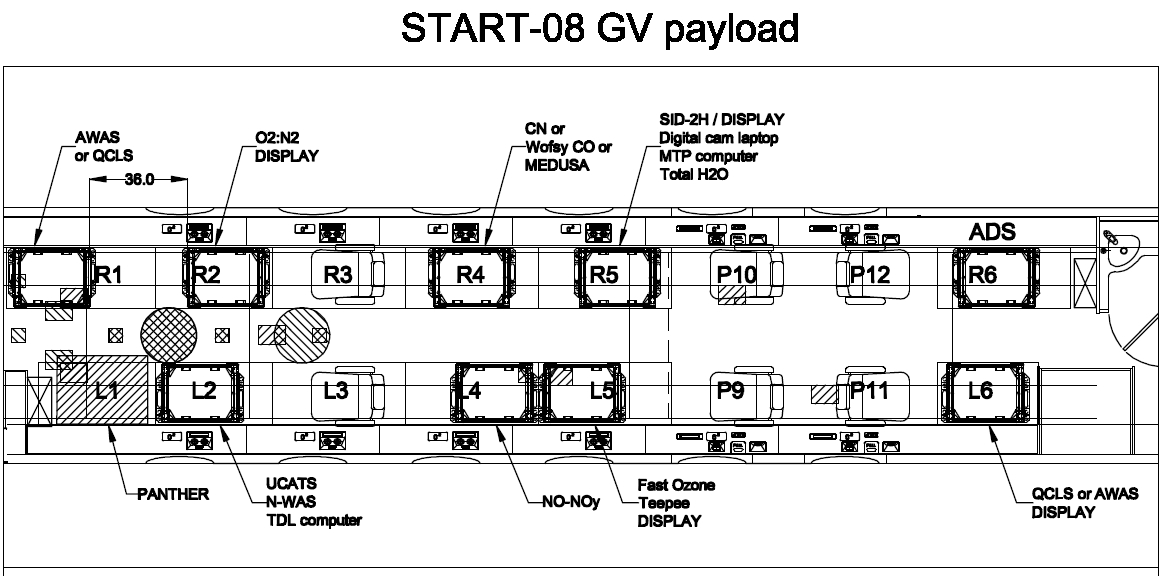Chair: E. Atlas
ACD: Sue Schauffler, Andy Weinheimer, Frank Flocke, Bill Hall, Simone Tilmes, Laura Pan
RAF: Pavel Romashkin
CU: Linnea Avallone, Dale Hurst, Fred Moore (?)
Texas A&M: Ken Bowman, Fuqing Zhang
JPL: M.J. Mahoney
Miami: Elliot Atlas
Harvard: Steve Wofsy
1. Instrumentation/certification telecon (Atlas)
No telecon conducted, but progress made in communication with instrument teams, and in scheduling and instrument layout.
2. Forecast/data management telecon (Bowman/Zhang)
No telecon yet, but plan to have discussions week of 17 Oct. or following week.
3. Planning of the workshop, including finalizing date and booking facility (Pan)
Workshop is planned for 8-9 January, 2008 at NCAR Center Green Campus. Announcements will be sent after the telecon if there is no conflict from the HIPPO project, and planning agenda and formats will be discussed among the START/HIPPO PI’s.
A. Flight planning plans (Pan)
Laura will begin the process of developing strawman flight plan scenarios. Prototype flight plans to address different science objectives will be developed. Each flight plan will identify forecast requirements and in-flight data requirements.
B. Modeling and satellite data involvement discussion/plans (Pan)
Laura reviewed interest and participation of groups who will participate in the START08/preHIPPO mission. New participants include: Karen Rosenlof and Eric Ray (NOAA/CIRES; forecasting); Jim Bresch (NCAR/MMM; forecasting); Doug Kinnison (MOZART3 and WACCM, with Simone Tilmes); Paul Konopka (CLAMS, modeling/forecasting); Lorenzo Polvani (Columbia Univ; modeling); Thomas Birner (CSU, modeling); HIRDLS group (J. Gille et al., satellite); Morris Weisman (NCAR; Advanced Research WRF-still to be confirmed).
C. forecast and data management plans ( Bowman and Zhang)
Ken B. have begun discussions of forecasting and data management strategies, and will organize a group telecon during October to further develop detailed requirements.
A. Field catalog (Pan)
Based on the utility of field catalogs in past campaigns, the involvement of EOL in helping develop a basic field catalog for START08 was recommended. Discussions will begin with Brigitte Baeuerle and Steve Williams to identify needs and associated costs.
B. Real time data and campaign period communication issues (Pan).
The general consensus was that the basic navigation and aircraft parameters that were available for real-time data communication should be available as part of the data stream sent from the aircraft to the ground. Any of the in-situ sensors that already had the capability of adding to the data stream would be useful, but development of this capability in new instruments was not necessary. Investigators should work through Pavel R. regarding adding instrument signals to the data stream.
Mechanisms for remote access the realtime data, forecast products, etc. needs to be defined, and this issue will be examined as part of the data management/forecasting group discussions.
C. Proposed certification/test flight schedule (HEFT and START) (Romashkin)
A proposed schedule for flights and flight certification was developed by Pavel. This preliminary schedule is shown below. Individual investigators will be contacted by RAF to discuss detailed timing of specific instrument integration.
December 15: certification documents delivered to RAF for HEFT08.
December 20-January 1: Upload begins for HEFT08, depending on when the GV will come back from wing stores test flights.
February 1: HEFT08 begins.
February 1-29: HEFT08 and GISMOS test flights.
March 1: Offload HEFT specific payload, install START08 payload.
April 14: START08 test flights begin. Expect two test flights.
April 21: START08 begins.
Note: NO-NOy, Fast ozone, AWAS will stay on the aircraft. SID-2H and MTP will stay on aircraft from HEFT into START.
D. Payload options (Atlas/Romashkin)
Pavel had developed a draft payload layout that is shown below. A separate figure that also shows inlet configurations is attached.

Final payload configuration requires some further discussion about instruments to be placed in Rack 4 (R4). Possible instrument combinations for this rack potentially include 2 of the following 4 instruments (depending on final weight/size/power of all of the instruments on the payload): a) VUV CO (NCAR); b) UV O3 (NOAA); c) Condensation Nuclei (RAF); d) MEDUSA (NCAR). Atlas requested input from the science team on the desired instrument combination for this final rack.
E. Other
No other items.
1) Develop workshop agenda/facility requirements (PI team)
2) Organize data management/forecast discussion (Bowman/Zhang)
3) Contact RAF regarding field catalog (Pan/Atlas/Bowman)